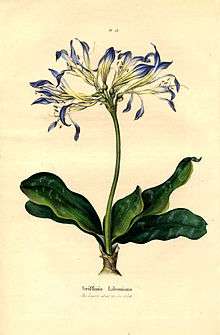Griffineae
| Griffineae | |
|---|---|
 | |
| Griffinia liboniana | |
| Scientific classification | |
| Kingdom: | Plantae |
| Clade: | Angiosperms |
| Clade: | Monocots |
| Order: | Asparagales |
| Family: | Amaryllidaceae |
| Subfamily: | Amaryllidoideae |
| Tribe: | Griffineae Ravenna[1] |
| Type genus | |
| Griffinia Ker-Gawl. | |
| Genera | |
| Synonyms | |
| |
The tribe Griffineae (in the family Amaryllidaceae, subfamily Amaryllidoideae) includes 2 genera with 22 species from South America which are actually endemic to Brazil. A typical character of the representatives of the tribe are the flowers - They are with blue or lilac color collected into an umbel. Only the members of this tribe and the genus Lycoris are able to form flowers with such color in the whole Amaryllidaceae family. The plants in this group are typical perennial flowers which are producing bulbs. The leaves are green, with elliptical form in the most of the cases but in some members as in Worsleya they are sword-shaped.[3]
Taxonomy
The Müller-Doblies' (1996) placed Griffinia in its own subtribe Griffiniinae (of tribe Hippeastreae) and did not recognise Worsleya, which they submerged in Phycella.[2] In contrast, Meerow and Snijman (1998) resureected it, placing both genera within Hippeastreae.[4] Subsequently, molecular phylogenetic studies demonstrated that Griffineae was a distinct and separate tribe.[5]
Phylogeny
The placement of Griffineae within subfamily Amaryllidoideae is shown in the following cladogram, where this tribe is shown as a sister group to the Hippeastreae, forming the Hippeastroid subclade, of two American clades:[6]
| Cladogram: Tribes of subfamily Amaryllidoideae | |||||||||||||||||||||||||||||||||||||||||||||||||||||||||||||||||||||||||||||||||||||||
| |||||||||||||||||||||||||||||||||||||||||||||||||||||||||||||||||||||||||||||||||||||||
Subdivision
Two genera:
References
- ↑ Ravenna P. (1974) Studies in the genus Griffinia. Plant Life 30: 64–70 (Pl. Life (Stanford) 30: 65 (1974)).
- 1 2 Müller-Doblies & Müller-Doblies 1996.
- ↑ Vigneron 2008.
- ↑ Meerow & Snijman 1998.
- ↑ Meerow & Snijman 2006.
- ↑ Meerow et al. 2000b.
Bibliography
- Meerow, Alan. Towards a phylogeny of the Amaryllidaceae. pp. 169–179., in Rudall et al. (1995)
- Müller-Doblies, U.; Müller-Doblies, D. (1996). "Tribes and subtribes and some species combinations in Amaryllidaceae J St Hil R Dahlgren & al. 1985". Feddes Repertorium. 107 (5–6): S.c.1–S.c.9.
- Meerow, AW; Snijman, DA. Amaryllidaceae. pp. 83–110. doi:10.1007/978-3-662-03533-7_11., in Kubitzki (1998). (additional excerpts)
- Meerow, Alan W.; Snijman, Deirdre A. (2006). "The never-ending story: multigene approaches to the phylogeny of Amaryllidaceae". Aliso. 22: 355–366. Retrieved 25 January 2015.
- Vigneron, Pascal (2008). "Amaryllidaceae". Amaryllidaceae.org (in French). Retrieved 23 October 2014.
- Stevens, P.F. (2001–2012), Angiosperm Phylogeny Website: Amaryllidoideae
- Rudall, P.J.; Cribb, P.J.; Cutler, D.F.; Humphries, C.J., eds. (1995). Monocotyledons: systematics and evolution (Proceedings of the International Symposium on Monocotyledons: Systematics and Evolution, Kew 1993). Kew: Royal Botanic Gardens. ISBN 978-0-947643-85-0. Retrieved 14 January 2014.
- Kubitzki, K., ed. (1998). The families and genera of vascular plants. Vol.3. Berlin, Germany: Springer-Verlag. ISBN 3-540-64060-6. Retrieved 14 January 2014.
- Meerow, A.W.; Fay, M.F.; Guy, C.L.; Li, Q.-B.; Zaman, F.Q.; Chase, M.W. (1999). "Systematics of Amaryllidaceae based on cladistic analysis of plastid rbcL and trnL-F sequence data". Am. J. Bot. 86 (9): 1325–1345. doi:10.2307/2656780. JSTOR 2656780. PMID 10487820.
- Meerow, A.W.; Guy, C.L.; Li, Q.-B.; Yang, S.-L. (2000). "Phylogeny of the American Amaryllidaceae Based on nrDNA ITS Sequences" (PDF). Systematic Botany. 25 (4): 708–726. doi:10.2307/2666729. Retrieved 25 January 2015.
- "Amaryllidaceae: A taxonomic tool for the Amaryllidaceae of the world". eMonocot.
External links
| Wikimedia Commons has media related to Griffineae. |
| Wikispecies has information related to: Griffineae |